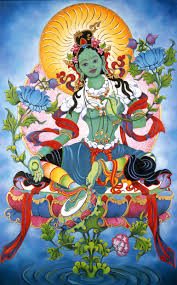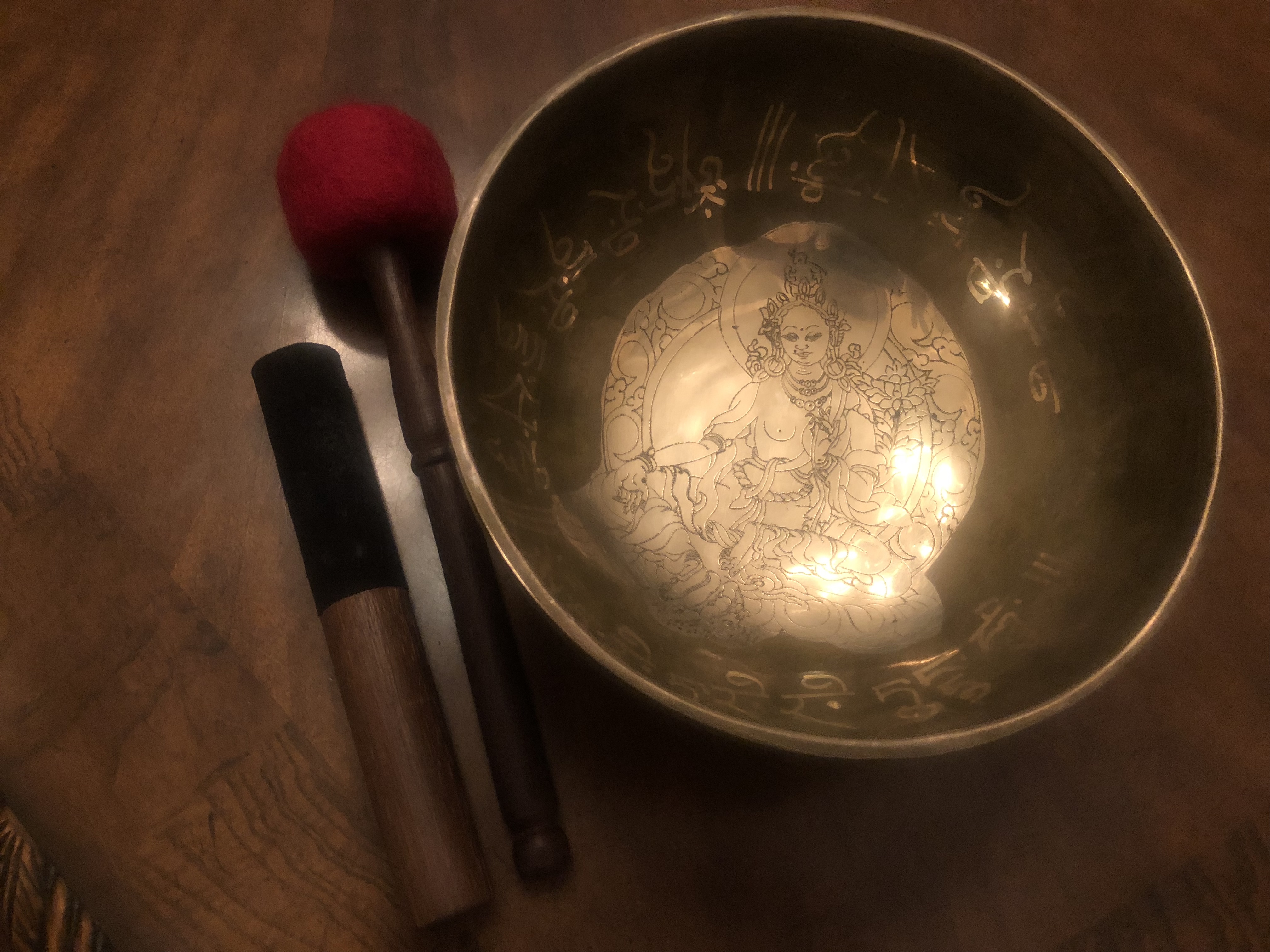Tibetan Singing Bowl
These exotic and unique Tibetan Singing Bowls are used for meditation, healing, as musical instruments and objects of art. Traditionally, Tibetan practitioners use the singing bowls in ritual for heightening spiritual awareness, clearing force fields, balancing energy, healing and meditation. Our bowl was hand-made in Tibet with seven different metals including copper, nickle, brass, iron zinc, gold and silver. All these metals have healing energy and are mind from the mother earth. Singing bowls are found in many different grades and quality. So, after many years of searching for the purest and a quality of sound that resonated with our spirits, we found one that is 70-80 years old that called to us. A good singing bowls is wise investment as you may enjoy it daily, treasure for ever and pass to the next generation with peace of mind.
This hand-hammered bowl was made in the 1940-50’s in Tibet and was hand carried by Thutop Yuthok, a native Tibetan who started out in life as a pastoral nomad in Tibet. He writes, “My family used to live in Yak wool tent, herding yaks, horses and sheep just like our ancestors had done for thousands of years with great freedom and happiness. I was six years old in 1959 when the Communist China brutally invaded my homeland. More than 1.2 million fellow Tibetans died and more than six thousand Buddhist monasteries and temples were destroyed by the Communist China’s military. My family evaded Chinese troops for almost a year and then walked down to a refugee camp in Pokhara, Nepal. I went to school in the refugee camp and learned English from some of the first Peace Corps Volunteers sent aboard in early 1960’s. For a time I earned my living as a trekking guide and then learned the Jewelry & Crafts Trade.”
 Our bowl has the image of the Green Tara etched by hand into the inside of the bowl and the Buddhist seeing eye on the outside of the bottom, and is covered with Tibetan prayers around the sides of both the inside and outside. Among the many aspects of Green Tara, as Mother, she offers feelings of safety, acceptance and love. Green Tara heals issues of loneliness, and disconnectedness that might arise from a lack of close family ties, dealing with an unskillful mother or suffering from a mother who has passed away. We can become naturally more gentle, kind and capable, while relating to others and become a better partner, parent, co-worker or friend.
Our bowl has the image of the Green Tara etched by hand into the inside of the bowl and the Buddhist seeing eye on the outside of the bottom, and is covered with Tibetan prayers around the sides of both the inside and outside. Among the many aspects of Green Tara, as Mother, she offers feelings of safety, acceptance and love. Green Tara heals issues of loneliness, and disconnectedness that might arise from a lack of close family ties, dealing with an unskillful mother or suffering from a mother who has passed away. We can become naturally more gentle, kind and capable, while relating to others and become a better partner, parent, co-worker or friend.
Singing bowls are actually a type of bell known as a “standing bell.” The bowls are played either by rubbing a mallet around the rim (as one might play a crystal glass with your finger), or striking the side of the bowl with the mallet. The two playing methods produce quite distinctive sounds. Though they are often referred to as Tibetan Singing Bowls, they are more accurately called Himalayan Bowls, as they are present throughout the Himalayan regions of Tibet, Nepal, India and Nepal. They can also be found in various manifestations in Japan, Korea, China and Mongolia. Today, singing bowls are used to aid meditation, religious practice, relaxation and healthcare.
When used in sound healing, singing bowls are sometimes referred to as healing bowls or chakra bowls. In sound healing, or “sound massage,” the bowls are played around and sometimes placed on the body of the receiver of the treatment. The practitioner uses the resonance of the bowls’ harmonic vibrations within the human body for balancing and relaxation. Some sound healers seek to activate or balance the body’s chakras, or energy centers. The “singing” sound is remarkable, a powerful, long-lasting harmonic hum that can be both invigorating and calming at the same time. The traditional methods of producing the bowls has been lost for at least 50 years, but the manufacturing methods used today can produce bowls with beautiful tones. Today, bowls are both hand-hammered and machine-made, or a combination of the two. The best modern bowls are considered to come from Nepal.
Modern bowls are most likely to be made of a type of bronze called “bell metal,” composed of a mix of copper and tin. Antique bowls were also typically made of high-quality bronze, with combinations of various other metals, including gold, silver and even highly-prized meteoric iron, which the Tibetans call “sky-metal” or thogcha. The presence of multiple kinds of ore is thought to to be the source of the multi-phonic overtones of some antique bowls, and along with the mellow tones created by age, accounts for the high value placed on antique singing bowls.
On the bottom of the bowl are the BUDDHA EYES or Wisdom Eyes: This symbol represents the all-seeing eyes of Buddha. In Nepal, this symbol is found on the majority of stupas (Buddhist temples) shown as giant pairs of eyes staring out from all four sides of the main tower. They look out in the four directions to symbolize the omniscience (all-seeing) of Buddha. The Buddha eyes are so prevalent throughout Nepal, they have become a symbol of the country itself. They can also be found etched, chiseled and painted on rocks or buildings.
The small dot between the eyes represents the third eye, a symbol of spiritual awakening. The curly mark between the eyes (where the nose would be) is the Sanskrit numeral one, which symbolizes the unity of all things and the one path to reach enlightenment—through the Buddha’s teachings.
From Laura Marshall’s great site http://lauramarshall.com/index.php/green-tara/ :
Green Tara, known as the Swift Liberator, represents the principle of Active Compassion in the tradition of Tibetan Buddhism. Her name in Tibetan is Drolma, the Mother Who Rescues. Tara is her name in Sanskrit. We see her seated on a lotus arising from a pool, for she (together with White Tara) is said to have arisen from the tears of Avalokiteshvara, the Bodhisattva of love and compassion, as he wept over the suffering in the world.
Green Tara sits in a posture of royal ease, a calm, radiant, sensual young woman, clothed in flowing, silken skirts, a white half blouse, and rainbow stockings. She is elegantly adorned with flowers, gold, and jewels, for her radiance and splendor is that of wisdom, compassion, and mercy, which she brings to the world. The ruby in the center of her tiara represents her kinship with Amitabha, the Buddha of Infinite Light.
Tara’s skin is green, for that is the color associated with wind, with breath, with prana and hence with movement and activity. She sits with her left leg folded under her and her right leg extended, for it is said that she is always, always ready to come swiftly and immediately to the assistance of anyone who calls upon her for help. The position of her legs also reflects her integration of contemplation and action.
Tara’s right hand is stretched out in a gesture, a mudra, that bestows blessings and offers refuge and protection. Her left hand is at her heart, in a mudra in which her thumb and ring finger are pressed together, symbolizing the union of wisdom and skillful means; her three remaining fingers are raised, symbolizing the Three Jewels of Refuge, Buddha (the seed, the potential for full awakening inherent in all beings), the Dharma (the way and laws of life, the knowledge and teaching of them), and Sangha (in the broadest sense meaning the community of beings with whom we share our lives). In each hand she holds a blue utpala flower, a “night blooming lotus”, each of which have three blossoms, telling us that Green Tara, as the embodiment of enlightened activity, is the mother of the buddhas of the past, present, and future.
Green Tara’s gaze is open, warm, and kind. As the principle of Active Compassion, she is immediately accessible to all who turn to her. She is known as a protrectress and one who comes swiftly to those who call upon her in times of danger. She is a protector of travelers, and women giving birth say her mantra. She gives comfort, help and protection in the most mundane of the difficulties and concerns of ordinary people. Traditionally she is known as ‘The One Who Rescues from the Eight Calamities’ or ‘Eight Great Fears’, which are: the fear of lions, elephants, snakes, fires, floods, robbers, demons, and imprisonment. Add to those the multitude of terrors that besets all who live in the early 21st century, such as terrorism, ecological devastation, nuclear annihilation, diseases such as cancer or AIDS, isolation and destitution ~ fears bearing the particular mark of our time. In particular, she protects us from the internal poisons and distortions wrought by fear, among them pride, ignorance, rage, wrong views, and doubt.
Some good books about Green Tara are: How to Free Your Mind: Tara the Liberator by Thubten Chodron, Snow Lion Publications 2005; The Cult of Tara: Magic and Ritual in Tibet by Stephen Beyer U. of California Press, 1973; Longing For Darkness by China Galland.
The Green Tara mantra is: OM TARE TUTTARE TURE SVAHA
GREEN TARA PRINTS
This is a richly colored, glossy, off-set print; it measures 29.5″ x 20″. 10% of the sale of each print will go to 10% of proceeds benefit the Bylakuppe Tibetan Children’s Village.
___________________________________________________________
What are Tibetan Singing Bowls?
For hundreds of years, Tibetans have practiced a form of sound healing and spiritual transformation leveraging a hand-made musical instrument known today as Tibetan Singing bowls. Traditionally, monks and Buddhists practitioners have used the bowls in rituals, prayers, and meditation, and their sounds and vibrations have been described as the “sound of the void” or “sound of the universe manifesting.” Made of a special seven-metal alloy of gold, silver, iron, mercury, tin, copper, and lead, each metal represents one of the seven chakras. They are made by monks who use a traditional process of shaping them with a hammer, while singing a series of sacred chants and mantras to infuse the bowls with healing intention.
What are the benefits of Tibetan Singing Bowl sound baths?
While western medicine is still catching up to the ancient wisdom of our ancestors around the world, sound healing with Tibetan Singing Bowls has been known to provide the following benefits:
- Reduction in tension, anxiety, and depression
- Balance of the chakras. According to many traditions, chakras are our energy centers, and it’s believed that physical and emotional challenges are the result of one or more chakras being blocked or unbalanced. The notes of the bowls correspond with each of the significant chakras. Keeping these facilities in harmony causes wellness and harmony.
- Immune system stimulation. “Sound can actually change our immune system,” explains Dr. Mitchell Gaynor, Director of Medical Oncology and Integrative Medicine at Cornell Cancer Prevention Center, author of “The Healing Power of Sound,” who used singing bowl therapy with his cancer patients.
- Lower Blood Pressure. A study published in the American Journal of Health Promotion found that singing bowl treatment resulted in a greater reduction in systolic blood pressure and heart rate. Others have found a reduction in cardiac complications among patients who have recently suffered heart attacks.
- Pain Management. The medical director of the Deepak Chopra Center in California, Dr. David Simon, found that “the sounds from Tibetan Singing Bowls, as well as chanting, are chemically metabolized into ‘endogenous opiates’, which act on the body as internal painkillers and healing agents.”
- Get “in the zone.” Move your brainwave frequencies into the theta zone to induce deep meditative and peaceful states, clarity of mind, and intuition. This positively affects our nervous system and engages our relaxation reflex while also inhibiting the pain or stress response. The upper end of the theta brainwave range is what is considered vital to the healing of the body, mind, and spirit.
________________________________
The Sherpa House in Golden is a great place to dine with an interesting collection of Tibetan singing bowls and some for sale in their gift shop. Don’t miss the garden.





